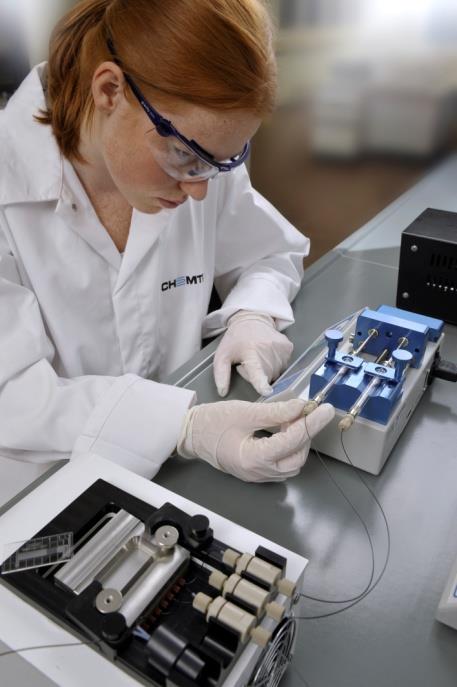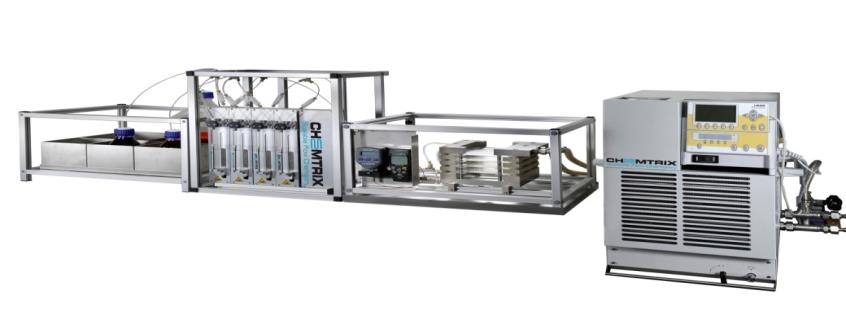Chemtrix - Scalable Flow Chemistry
Submitting Institution
University of HullUnit of Assessment
ChemistrySummary Impact Type
TechnologicalResearch Subject Area(s)
Chemical Sciences: Inorganic Chemistry
Engineering: Chemical Engineering, Interdisciplinary Engineering
Summary of the impact
Chemtrix Ltd. was established in February 2006 as a 50-50 joint venture
between the University of
Hull and Lionix Ltd. In 2008 the company attracted investment from Limburg
Ventures BV,
Panthera, Technostartersfund, Microfix BV and Hugo Delissen (€2 million)
that led to the creation
of Chemtrix BV. In 2009 the Company launched Chemtrix USA and a second
investment round
followed with investors Particon BV. In 2012 ESK Ceramics GmbH & Co.
KG, acquired a minority
interest (30%) in Chemtrix BV based on a valuation of €5.3 million.
The three products developed and marketed by Chemtix, Labtrix®,
KiloFlow® and Plantrix®, are
differentiated from competitor products as they offer `scalable flow
chemistry', such that optimised
reaction conditions can be easily scaled from R&D to production. In
addition to the employees and
investors in Chemtrix the main non-academic beneficiaries of the research
have been industrial
customers such as Janssen Pharmaceutica NV, Edward Air Force Base, Iolitec
GmbH and DSM.
Underpinning research
In the early 1990s a small number of researchers (7-8 academics) mainly
from Europe, the USA
and Japan started to develop microfluidic based methodology which built on
techniques drawn
from the semiconductor industry (in particular photolithography and wet
etching) in an attempt to
produce so called micro total analytical systems. Professor Haswell, one
of these pioneers,
published the first micron-scale flow injection analysis system in 1995
and started to develop micro
reactor technology.1 This activity became instrumental in
securing a prestigious multi
university/industry £5 million Foresight LINK grant in 1999 that in turn
was used by the DTI (now
TSB) to establish a strategic national focus for the micro- and
nano-technology. The research of
Professor Haswell since 1993 has lead to over 180 peer reviewed
publications and 10 patents in
the field which have focused on establishing the fundamental design and
operational parameters of
flow reactors which gives the methodology significant advantages in the
fields of synthetic and
analytical chemistry.2-6 These advantages can be attributed to
the unique operating conditions
associated with meso/micro flow-reactor devices in which the spatial and
temporal control of
reagents is achieved under a non-turbulent, diffusion limited mixing
regime. Within such systems
the control of hydrostatic and other pressure gradients, the
immobilization of catalysts (Pd, Pt,
sulphated zirconia, zeolites and enzymes) and the monitoring of reactants
and products have
featured strongly. A range of chemical reaction types have been carried
out to demonstrate the
advantages meso/micro flow-reactors offer in terms of stereoselective
product control, multi-step
synthesis and in-situ separations. In addition, mathematical
models of reactions in meso/micro
flow-reactors under electrokinetic and hydrodynamic control have been
successfully constructed
and validated using in-situ measurements of spatially and
temporally resolved concentration
profiles.
In 2002 a previous postdoctoral fellow of Professor Haswell, Dr Paul
Watts (Lecturer, University of
Hull; 2002 to 2013) and a former PhD student and postdoctoral researcher
Dr Charlotte Wiles
(PhD Student, University of Hull; 2000 to 2003 and post doctoral
researcher, University of Hull;
2003 to 2005) seized the opportunity to commercially develop the
underpinning research carried
out at Hull, focusing in particular on the up-scaling (volume increase) of
micro-reactor methodology
whilst retaining the inherent operational advantages of excellent reaction
control and efficiency. In
partnership with the University of Hull and Lionix, Chemtrix BV was
established to develop micro-reactor
based operating systems for industrial applications of flow chemistry.
Charlotte Wiles is
now the Chief Executive Officer with Chemtrix BV. The research carried out
at Hull in the field of
micro-reactors has therefore been instrumental in establishing the core
technology on which
Chemtrix has now developed innovative products that have lead to a
significant growth and
internationalisation of the business; with industrial customers in Europe,
UK, USA, Israel, India,
Taiwan, Korea, China and Australia.
References to the research
(1) Development of a micro flow injection manifold for the determination
of orthophosphate,
R.N.C. Daykin and S.J. Haswell, Analytica Chimica Acta, 1995, 313,
155-159.
(2) Theoretical investigation into the rates of chemical reactions in
micro-total analytical systems
(µTAS) operating under electroosmotic and electrophoretic control,
P.D.I. Fletcher, S.J. Haswell and V.N. Paunov, Analyst, 1999, 124,
1273-1282.
(3) The use of novel microreactors for high throughput continuous flow
organic synthesis, G.M.
Greenway, S.J. Haswell, D.O. Morgan, V. Skelton and P. Styring, Sensors
and Actuators B,
2000, 63, 153-158.
(4) Micro reactors: principles and applications in organic synthesis,
P.D.I. Fletcher, S.J. Haswell,
E. Pombo-Villar, B.H. Warrington, P. Watts, S.Y.F. Wong and X.L. Zhang, Tetrahedron,
2002, 58, 4735-4757.
(5) Electrokinetic control of a chemical reaction in a lab-on-a- chip
micro-reactor: measurement
and quantitative modelling, P.D.I. Fletcher, S.J. Haswell and X.L. Zhang,
Lab on a Chip,
2002, 2, 102-112.
(6) Pressure-driven and electroosmotic flows and electrical currents in
Lab-on-a-chip micro
reactor devices, I. Broadwell, P.D.I. Fletcher, S.J. Haswell, X.L. Zhang,
R.W.K. Allen, J.M.
MacInnes and X. Du, Trends in Physical Chemistry, 2004, 10,
117-133.
Details of the impact
Key impacts have been:
- 2 new businesses (Chemtrix BV and ChemtrixUSA).
- 13 jobs created including 4 PhDs, 3 MScs and 4 engineers.
- The development of 3 innovative products (Labtrix®□
KiloFlow® and Plantrix®) with a growing
international industrial and academic customer base.
New businesses: After receiving substantial investment from Dutch
investors, the Headquarters of
Chemtrix was established in Geleen (Netherlands) in April 2008; and
product development and
sales actively commenced. Chemtrix Ltd.[A] remains the holding
company trading under the name
`Chemtrix BV'. In 2009 Chemtrix USA was registered to facilitate sales in
North America and
Canada whilst management and product development/engineering remains in
the Netherlands and
R&D at The University of Hull where 2 full-time employees (Drs Wiles
and Ngamsom, previous Hull
postdoctoral workers) develop customer-initiated processes/products
related to process
optimisation. In total Chemtrix BV employs 11 full time staff (split
between the Netherlands and UK)
and Chemtrix USA has 2 employees. In addition Chemtrix has sales
representatives in Europe,
Taiwan, India, Israel, Korea and China; and is actively investigating
other worldwide market
opportunities with the Asian market developing rapidly.
Instrumental in securing initial investment were two patent families
licensed from the University of
Hull and two patents licensed from Lionix, BV. Since then, Chemtrix has
applied for two patents
[B,C] with two more patent applications are in progress, IP generation
remains key to the on-going
technical development of the Company.
New innovative products: Based on early research conducted at
Hull, the commercial advantages
of micro-reactor technology, as it relates to organic synthesis under flow
conditions, has underpinned
the development of new products which now meet previously unfulfilled
industry needs [D] (Figures 1-3).
Competitor analysis reveals that other micro-reactor companies either
specialise in small scale
screening equipment (e.g. Syrris, Mikroglas, Future Chemistry) or
large scale production systems
(e.g. Corning, Alfa Lafal) and it is not facile to directly
translate research from one system to another.
Chemtrix believes that it is the only Company currently developing
equipment to directly link both
markets; specifically using the slogan `scalable flow chemistry'.
The first product launched was Labtrix® (2009), a fully
automated flow reactor platform (Figure 1a)
containing a glass micro-reactor (Figure 1b) (volume 1-20 µL), allowing
processes to be optimized
using minute quantities of reagent (200 experiments day-1 using
10's mg of material[C]).
Furthermore, the equipment enables researchers to conduct organic
synthesis more safely[D] as
well as generating less chemical waste. Independent evidence is reported
by Ley.[E] In addition,
Chemtrix is the only micro-reactor supplier to manufacture a reactor
(Figure 1c) that enables the
incorporation of heterogeneous catalysts.[D]


 Figure 1. (a) Labtrix® system (launched 2009) and (b/c)
micro reactors.
Figure 1. (a) Labtrix® system (launched 2009) and (b/c)
micro reactors.
Through discussions with industry it was identified that although process
chemists are content
using fully automated computer controlled equipment, many bench chemists
prefer manual
equipment. Consequently, reacting to market demand, Chemtrix in 2010
launched Labtrix® Start
(Figure 2). Sales of this product have been particularly high, both within
academia and industry
(independent evidence reported by Kappe[F]) with more than 40
units of this type sold to date ~
40:60 academic to industrial end users.
 Figure 2 Labtrix® Start (launched 2010).
Figure 2 Labtrix® Start (launched 2010).
Scale up production from Labtrix®using `meso' scale reactors
(KiloFlow® launched 2011, 3 installed and 2 in production)
which consists of mm-size channels (Figure 3a). Through
carrying out detailed ongoing research into available static
mixer technology, the Company has developed the ability to
translate the reaction conditions identified in micro-channels to
meso-channels, where combination of these modules (Figure
4b) affords access to production-scale quantities (g-kg's) within
a standard laboratory fume cupboard.[G,H] A partnership with
ESK has enabled Chemtrix to develop silicon carbide reactors
capable of achieving production rates at the tonne-scale (Figure
3b) which will service a growing industrial market estimated to
be € 50million.[I] This partnership was strategic in giving
Chemtrix access to larger production units and ESK access to
the continuous flow reaction knowledge of Chemtrix.

 Figure 3. (a) KiloFlow® system (launched 2011) and (b)
Plantrix® system.
Figure 3. (a) KiloFlow® system (launched 2011) and (b)
Plantrix® system.
Chemtrix is working closely with major international pharmaceutical and
fine chemical companies
(under CDAs and NDAs), with publicised examples including Sanofi-Aventis
(Hungary),[J] DSM
Pharmaceutical Products (NL), Janssen Phamaceutica NV (Belgium) and
Iolitec GmbH (Germany)
who presented results at a Symposia held at CPhI 2011 and Flow Chemistry
Europe, Munich,
2011. The work focuses on access to new processing conditions (higher
temperatures & pressure)
with simplified synthetic processes that can be transferred from R&D
to production. In one
example, a new route for an API was identified at the lab-scale, resulting
in an increase in product
purity which upon transfer to the production plant led to significant cost
savings due to a reduction
in the complexity of the downstream separation process. In addition to the
publicised work,
Chemtrix are currently working on multiple projects with industrial
partners focussing on the
translation of batch processes to continuous flow, with the aim of
developing sustainable, cost
effective production processes. Chemtrix maintains its links to the
University of Hull, collaborating
in the development of new chemical processes beyond those initially
identified as having
commercial interest; this includes for example the synthesis of inorganic
nanoparticles with Dr
Grazia Francesconi.[K]
Sources to corroborate the impact
[A] www.chemtrix.com/company-profile
(corroboration of the establishment of Chemtrix BV and ChemtrixUSA)
[B] Patent Application - `A microfluidic system and the use thereof'
EP2010/002777.
[C] Patent Application — `A new design microfluidic device, a kit of
parts comprising such
microfluidic devices and a modular system comprising such microfluidic
devices'
EP10008784.0.
[D] Microreactors as tools for high-throughput synthesis, C. Wiles and P.
Watts,
Speciality Chemicals Magazine, 2009, 40-41.; The evaluation of the
heterogeneously
catalysed Strecker reaction conducted under continuous flow, C. Wiles and
P. Watts,
Eur. J. Orgc. Chem., 2008, 5597-5613.
[E] The flow synthesis of heterocycles for natural product and medicinal
chemistry, M. Baumann,
I. R. Baxendale and S. V. Ley, Mol. Divers., 2011, 5,
613-630.
[F] The microwave to flow paradigm: Translating high-temperature batch
microwave chemistry
to scalable continuous flow processes, T. Glasnov and C.O. Kappe, Chem.
Eur. J., 2011, 17,
11956-11968.
[G] Chemtrix' KiloFlow: The turn-key kilo-lab in your fume hood, C.
Wiles,
Chem. Today, 2011, 29, 32-33.
[H] Flexible Durchflussreaktoren für das schnelle Scale-up von
Produktionsprozessen, C. Wiles
and M. Seipel, Process, 2012, 1, 42-44.
[I] Innovative solutions to fulfill the flow chemistry potentials in
Europe, L. Pichon, 4th
Symposium on continuous flow reactor technology for industrial
applications, 2012, Lisbon.
[J] Formation of aromatic amidoximes with hydroxylamine using
microreactor technology',
Voros, Z. Baan, P. Mizsey and Z. Finta, Org. Proc. Res. Dev.,
2012, 16, 1717-1726.
[K] The preparation of magnetic iron oxide nanoparticles in
microreactors, M. Simmons, C.
Wiles, V. Rocher, M. G. Francesconi and P. Watts, J. Flow Chem.,
2013, 3, 7-10.